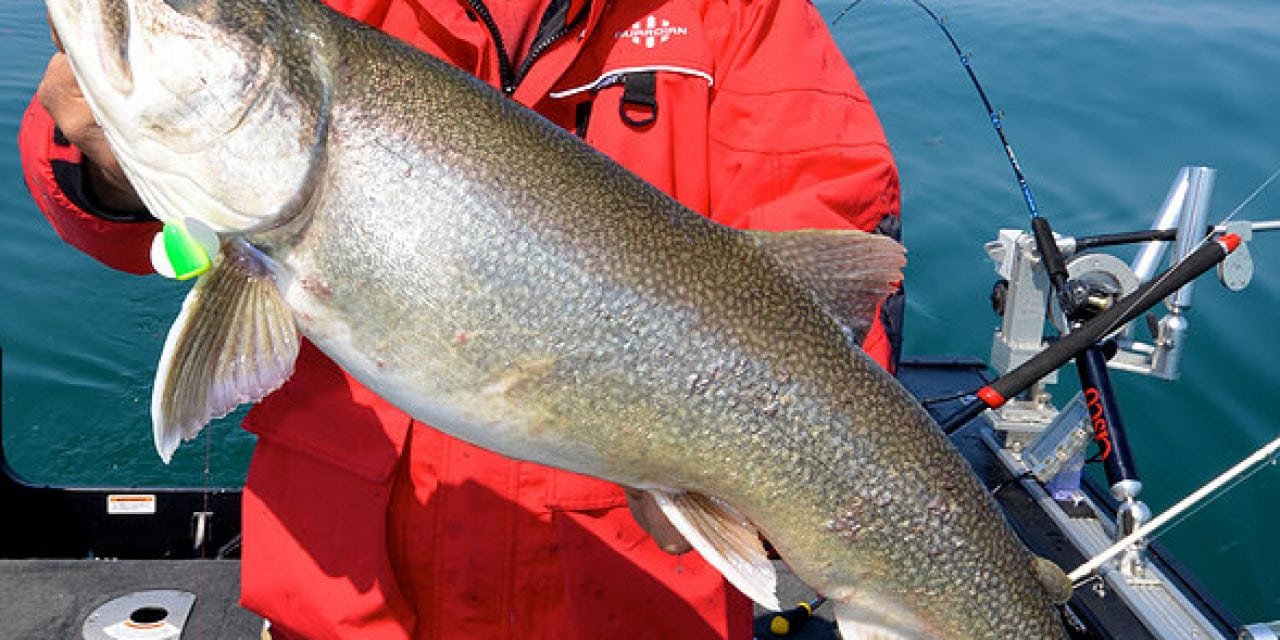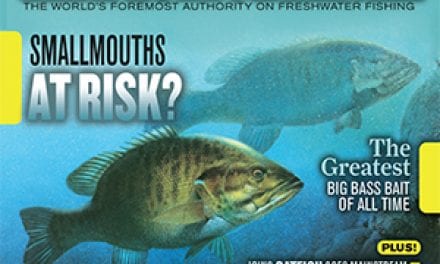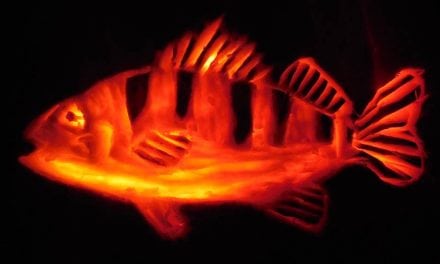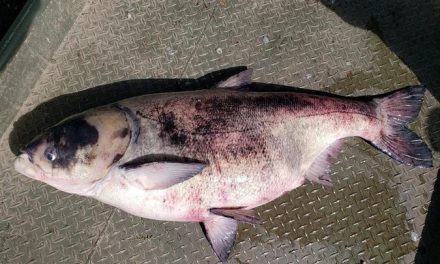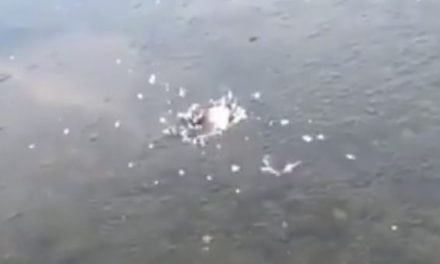Of the six trout and salmon game fish species found in the Great Lakes, only one is indigenous. Species like king and coho salmon, steelhead, brown trout and Atlantic salmon were introduced so long ago, most people think of these species as native. The lake trout is the sixth species of trout and salmon found in the Great Lakes and the only one that is indigenous.
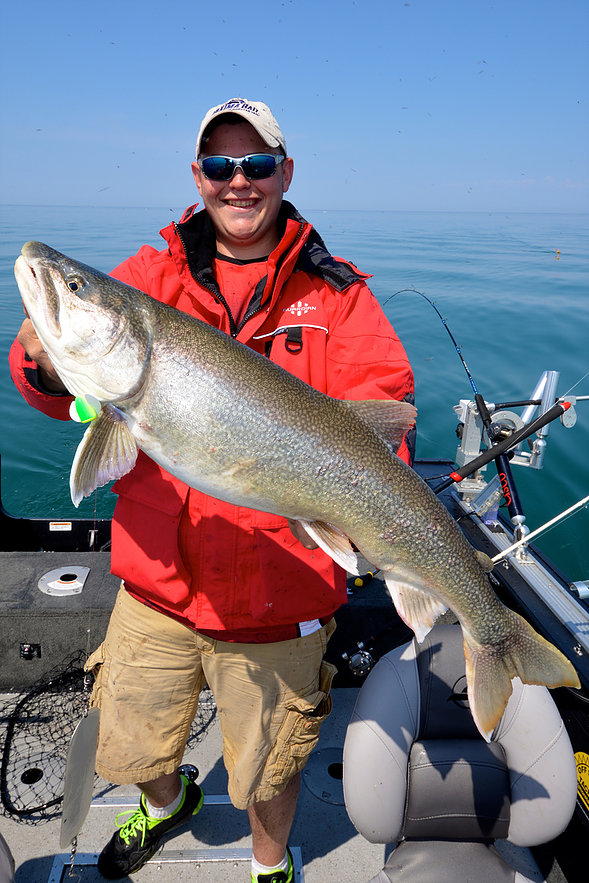
On those humid day lake trout love a Spin n Glo near bottom fished 18 inches behind a dodger. This fish from the Niagara Bar of Lake Ontario came during an epic bug hatch!
To confuse things a little more, lake trout aren’t even members of the trout family. Instead, the lake trout is the largest member of the char family.
Lake trout in the Great Lakes grow big and that’s part of their charm. Currently, the largest lake trout caught on hook and line was taken back in 1997 in Lake Superior. This particular denizen of the deep weighted an amazing 61.5 pounds and stretched 49 inches long.
It’s also interesting to note that as the Great Lakes evolve, lake trout are one of the species that seemingly have found a niche among these environmental changes. The most noteworthy environmental change centers on the plankton levels of the Great Lakes. Slowly over a time a couple of siphon feeders known as the zebra and quagga mussels, have been responsible for consuming massive amounts of plankton from the Great Lakes.
As plankton levels drop, so have the populations of important forage species that feed on plankton such as smelt, alewife and gizzard shad. As these pelagic forage fish have in turn declined, popular species like king and coho salmon have found it increasingly difficult to find enough to eat.
Fisheries biologists have been forced to reduce stocking efforts of king and coho salmon in places like Lakes Michigan and Huron and also other popular species such as steelhead and brown trout to avoid doing permanent damage to these critically important forage species.
As plankton levels have dropped and also the population of plankton feeding forage species, a new niche has been created for another evasive species known as the round goby. Ironically, goby feed primarily on mussels and some game fish species like the bottom loving lake trout have taken to eating goby at every opportunity.
BOTTOM FEEDERS
It’s no secret that lake trout love to feed on the bottom. An iconic trolling presentation known as the dodger and Spin-n-Glo has been catching lakers in the Great Lakes for decades. Dodgers are a popular attractor produced by several manufacturers and they also come in several different sizes. Overwhelmingly the most popular dodger for lake trout fishing are models that are just under six inches in length.
The most popular dodger finishes for lake trout fishing include trash can or buffed silver, chartreuse, chartreuse/lime green and chartreuse silver flash combinations.
Lots of different rigs are fished with dodgers for lake trout, but the Spin-n-Glo rig is hands down the most productive set up. A No. 4, 2 or 0 size Spin-n-Glo body is rigged onto a 18 to 24 inch leader of 25 pound test fluorocarbon line. A No. 4 treble hook is first snelled onto the leader, then a couple of beads threaded onto the line to act as a bushing for the Spin-n-Glo to spin against. The Spin-n-Glo body is then threaded onto the leader with the blunt end pointing towards the dodger. A loop knot is tied in the end of the leader and this loop is threaded onto the pig tail mounted to the back of the dodger.
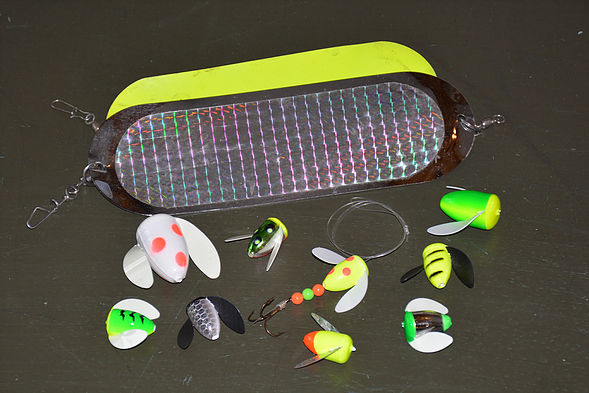
The dodger and Spin-n-Glo combination has caught legions of lake trout in the Great Lakes and beyond. The most popular dodgers are about six inches in length and No. 4, 2 and 0 size Spin-n-Glo bodies are productive on lakers.
Spin-n-Glo bodies come in hundreds of color and wing configurations. A few of the most popular choices for lake trout include the clown/white wings, double trouble green/white wings, lime/chartreuse/white wings, metallic chartreuse/lime/silver wings, luminous spot/silver wing, clown/chartreuse wing, lime/chartreuse/chartreuse wing and pearl clown/glo wing.
GETTING DOWN WITH DOWNRIGGERS
The dodger and Spin-n-Glo is most commonly fished near bottom using a downrigger. Set the dodger and Spin-n-Glo 20 to 30 feet behind the boat, attach the line to the downrigger line release and lower the downrigger ball and trailing dodger rig until it makes contact with the bottom.
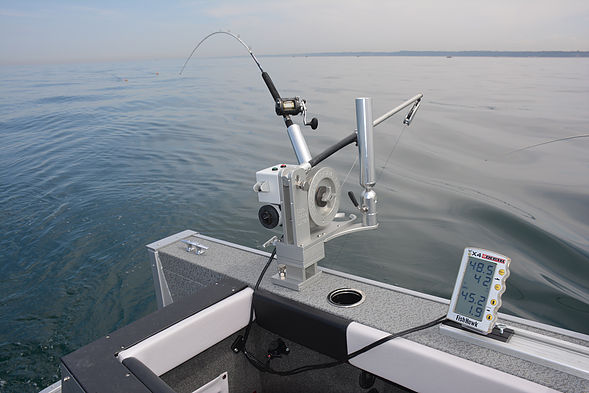
Downriggers are critically important to targeting lake trout that are often found near bottom in deep water. In this photo another piece of invaluable equipment, the Fish Hawk X4D is displaying important information including water temperature at depth and also trolling speed at depth. Catching lake trout with the iconic dodger and Spin-n-Glo rig requires maintaining a very specific trolling speed that ranges from 1.7 to 2.0 MPH.
Ideally the downrigger ball should make contact with bottom every few feet while trolling, stirring up sediment that simulates trout feeding on the bottom. The trailing dodger and Spin-n-Glo in turn snaps side to side kicking out fish attracting flash and fishing directly in this sediment cloud.
A couple common mistakes are made when fishing the dodger and Spin-n-Glo. Many anglers are reluctant to fish their downrigger balls in contact with the bottom, fearing they will snag and lose valuable gear. It’s important to make contact with the bottom to generate the sediment cloud that simulates feeding trout.
Trolling speed is the next most commonly made mistake. A dodger is designed to be fished slowly to bring out the side to side snapping action. For lake trout fishing the ideal dodger speed is a rather narrow window that ranges from 1.7 to 2.0 MPH. At slower speeds the dodger doesn’t have much snap and at faster speeds the dodger snaps too aggressively.
GETTING DOWN WITH DIVERS
The dodger and Spin-n-Glo rig can also be fished near bottom with the help of popular diving planers like the Slide Diver. The larger sizes of these divers with the dive rings installed and the diver set on the No. 1 or 2 outboard setting are most commonly used to target bottom hugging lakers.
The same dodger and Spin-n-Glo rig used with downrigger fishing can also be used with the Slide Diver. The main line slides through the Slide Diver allowing anglers to fish any combination of leads behind the diver. When a fish is hooked, the Slide Diver releases and slides down the line to a barrel swivel located just in front of the dodger.
A common set up when targeting trout with the Slide Diver is to fish the dodger and Spin-n-Glo about 20 feet behind the diver. Let out enough line that the Slide Diver makes contact with the bottom, stirring up a sediment cloud similar to the downrigger set up.
The Slide Diver set on the No. 1 or 2 outboard setting doesn’t dive straight down, but rather dives down and planes out to the side of the boat a few feet. The unique planing ability of these divers allows them to be used in combination with other trolling gear like downriggers.
DOUBLING DOWN
By combining lines fished on downriggers and other lines fished with Slide Divers trout fishermen can set up a four or five rod trolling pattern that puts a lot of gear in the water. Lake trout are notorious for hanging out right on the edge of drop offs, forcing anglers to fish key edges of structure to be successful. It’s also common for lakers to be found on flats where soft bottom areas merge with firmer gravel and rock strewn bottoms.
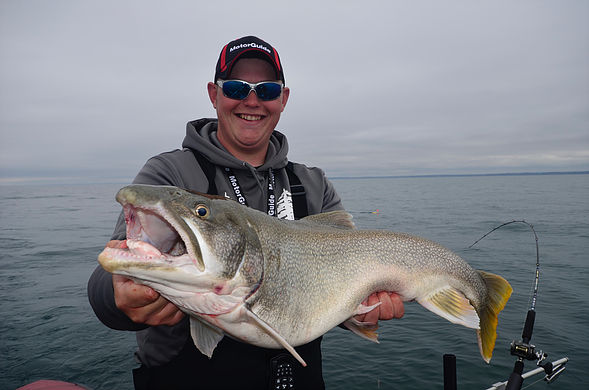
Monster sized lake trout like this are routinely caught in the Great Lakes by anglers who know the magic of using a dodger and Spin-n-Glo body. The Spin-n-Glo is a spinning float manufactured by Yakima Bait that has become iconic in it’s ability to catch bottom hugging lake trout. Jake Romanack caught this impressive fish using a dodger and Spin-n-Glo fished near bottom using a downrigger. All five of the Great Lakes have abundant populations of lake trout just waiting to be caught.
SPEED REFINEMENTS
As mentioned previously the ideal trolling speed when fishing a dodger and Spin-n-Glo is a narrow window ranging from 1.7 to 2.0 MPH. Boats that do not have a gasoline kicker motor will need to deploy sea bags to get the trolling speed in order. Maintaining these rather precise trolling speeds is difficult without incorporating the help of a sub-surface speed and temperature probe that is deployed with the downrigger.
The Fish Hawk X4D uses a transducer based signal to provide critically important water temperature at depth and also trolling speed at depth. Lake trout prefer to hang out in water that is cooler than 55 degrees and confirming trolling speed at depth lends tremendous confidence when fishing speed dependent rigs like the dodger Spin-n-Glo.
SUMMING IT UP
As salmon numbers decline in the Great Lakes, it’s the lake trout that is picking up the slack. To anglers who routinely troll the dodger and Spin-n-Glo for lake trout it comes as no secret that this simple presentation is deadly effective. To say this rig is the “go to” of most captains and serious anglers in the Great Lakes would be an understatement.
The hardest part about catching a limit of lake trout with the Spin-n-Glo is settling on a size and color from the hundreds of fish catching patterns to choose from.
The post Spin In With Yakima For Lake Trout appeared first on .

